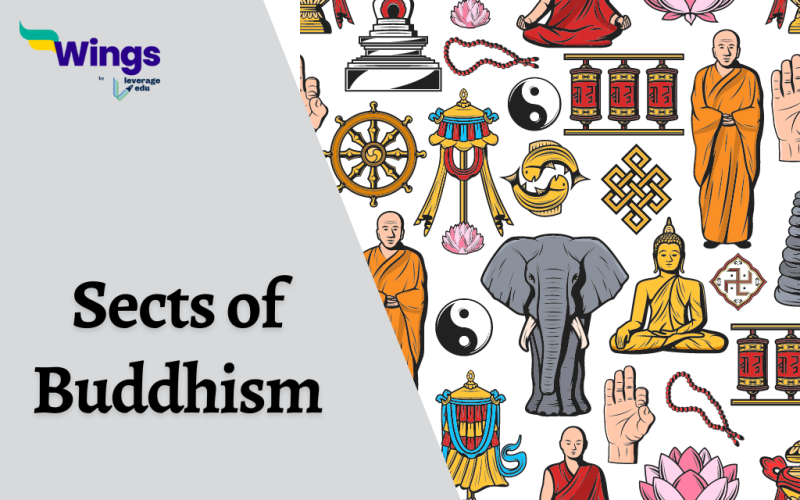Buddhism is one of the world’s major religions which is practised by millions of people globally. It offers a spiritual path that leads to enlightenment and inner peace. These are thoughts originally taught by Gautama Buddha. Over time, Buddhism branched out into different schools and traditions, each with its unique practices and interpretations. In this article, we will explore the various sects of Buddhism that emerged in ancient India and delve into their unique characteristics and contributions.
Table of Contents [show]
What are the Branches of Buddhism?
There are various classifications among scholars of Buddhism existing in the world. According to Buddhist texts, there are 64 sects or schools of Buddhism. As the teachers travelled around the world their philosophies propagated with having disciples who believed them. These are some of the branches of Buddhism –
1. Theravada Buddhism:
- Originated in ancient India and is the oldest existing Buddhist sect.
- Also known as the “School of the Elders” or “Hinayana” (lesser vehicle).
- Places great emphasis on the original teachings of the Buddha, preserved in the Pali Canon.
- Popular in Sri Lanka, Thailand, Cambodia, Laos, and Myanmar.
- Monasticism is highly regarded, and monks play a crucial role in preserving and disseminating Buddhist teachings.
- Emphasizes individual effort and self-liberation through meditation and mindfulness practice.
- They do not believe in idol worshipping and have orthodox thoughts in nature.
- They have sub-schools known as – Staviravadin or Theravadins, Sarvastivada, Mahasanghika and Sammitiya.

Fun Fact
Gautam Buddha was the Founder of Buddhism. He got enlightenment under a Bodhi tree and later, spread the teachings amongst his disciples throughout his life.
Also Read – Gautam Buddha: Real Name, Life and Teachings
2. Mahayana Buddhism:
- Originated in ancient India and spread to East Asia, including China, Japan, Korea, and Vietnam.
- Known as the “Great Vehicle” or “Bodhisattva Vehicle.”
- Emphasizes compassion, altruism, and the pursuit of enlightenment not only for oneself but also for the benefit of all sentient beings.
- Significant scriptures include the Lotus Sutra, Diamond Sutra, and Heart Sutra.
- Places importance on the concept of bodhisattvas, enlightened beings who postpone their own liberation to help others.
- Practices include chanting, meditation, and rituals performed for the welfare of all beings.
- Other Sub-schools of Mahayana Buddhism are – Yogachara School or Vigyanvada and Madhyamaka School or Sunyavada.
Also Read – What are the Four Noble Truths of Buddhism in English?
3. Vajrayana Buddhism:
- Also known as Tibetan Buddhism or the “Diamond Vehicle.”
- Flourished in Tibet, Bhutan, Nepal, and parts of China.
- Places great importance on meditation, rituals, and the transmission of teachings from guru to disciple.
- Incorporates tantric practices, including visualization, mantra recitation, and the use of ritual objects.
- Believes in the swift attainment of enlightenment within this lifetime.
- Dalai Lama, the spiritual leader of Tibetan Buddhism, is revered worldwide.
- They have the mantra “Om Mani Padme Hum”, believed to shower some magical powers.
4. Zen Buddhism:
- Originated in China and later spread to Japan, Korea, and Vietnam.
- Known for its emphasis on direct experience and meditation.
- Zen practice involves sitting meditation (zazen), koan study, and interaction with a teacher (roshi).
- Emphasizes the importance of mindfulness and everyday activities as opportunities for awakening.
- Famous for its minimalist aesthetics, including rock gardens and tea ceremonies.
- Encourages the idea of sudden enlightenment or intuitive understanding of one’s true nature.
Also Read – What are the Noble Eight-Fold Paths of Buddhism?
5. Pure Land Buddhism:
- Originated in ancient India and gained prominence in China and Japan.
- Devotional sect that places great faith in the Amitabha Buddha, also known as Amida Buddha.
- Teaches that rebirth in the Pure Land can be attained through faith and recitation of the Buddha’s name.
- Emphasizes the reliance on Amida Buddha’s infinite compassion for attaining enlightenment.
- Practices include chanting the nembutsu (Buddha’s name), visualization, and aspiration towards the Pure Land.
- Provides a path accessible to people with limited time or ability to engage in extensive meditation practice.
6. Nichiren Buddhism :
- Founded by the Japanese monk Nichiren in the 13th century.
- Places central focus on the Lotus Sutra as the ultimate teaching of Buddhism.
- Advocates chanting the mantra “Nam-Myoho-Renge-Kyo” as the primary practice for attaining enlightenment.
- Emphasizes the idea of absolute happiness and the achievement of one’s greatest potential in the present life.
- Believes in the inherent dignity and equality of all individuals.
- Known for its socially engaged Buddhism and activism for peace and human rights.
Also Read –Buddhist Education System: Features, Role & Merits
In conclusion, Buddhism encompasses sects, each with its own unique teachings, practices, and contributions. From the Theravada tradition’s emphasis on the original teachings of the Buddha to the Mahayana emphasis on compassion and the Vajrayana sect’s tantric practices, Buddhism offers a diverse array of spiritual paths. Whether it be the Zen tradition’s focus on direct experience or the Pure Land sect’s devotional practices, each sect offers its adherents a means to cultivate mindfulness, wisdom, and compassion on their journey towards enlightenment.
Related Blogs
| Sangam Age and Literature | Vedic Period |
| Ancient Indian Languages | Arrival of the East India Company and Its Expansion |
| Stone Age Tools | Ashoka |
This blog was all about the different Sects of Buddhism. If you want to know more about topics like this, then visit our general knowledge page! Alternatively, you can also read our blog on general knowledge for competitive exams!
 One app for all your study abroad needs
One app for all your study abroad needs















 45,000+ students trusted us with their dreams. Take the first step today!
45,000+ students trusted us with their dreams. Take the first step today!
